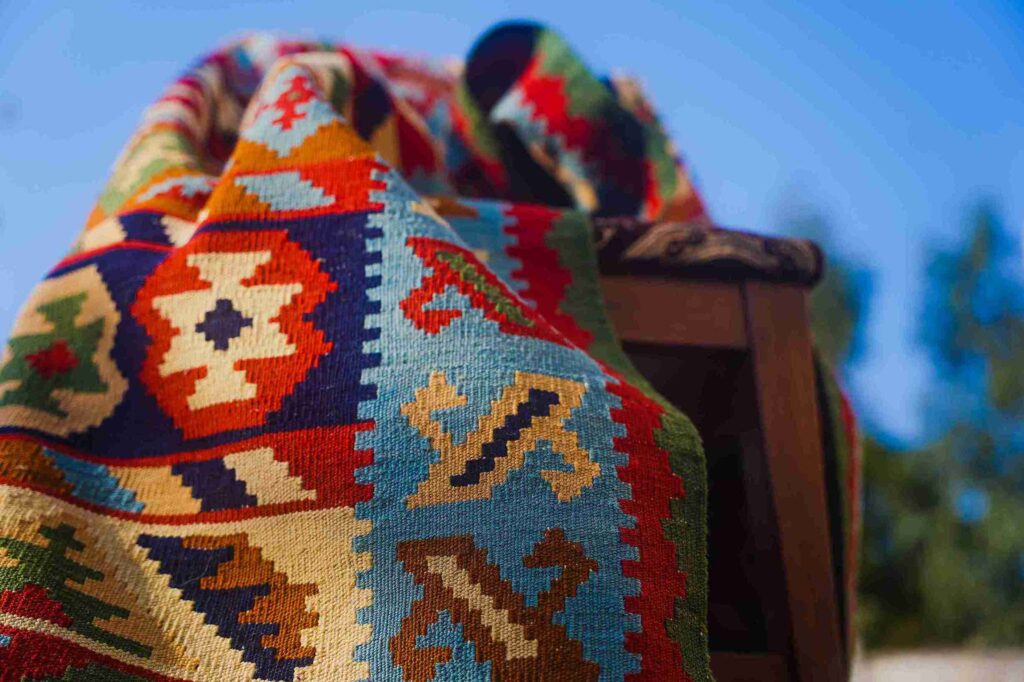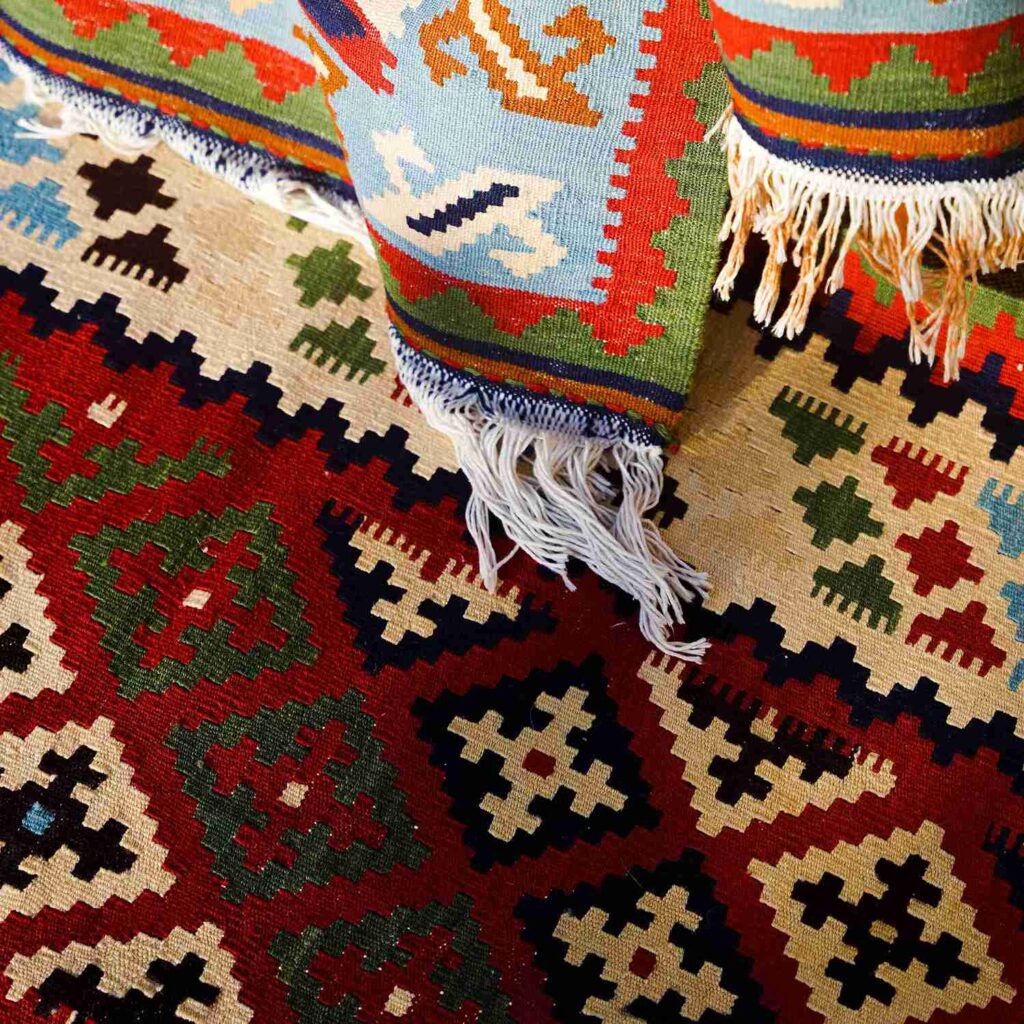Kilim Rugs
About Kilim Rugs
Kilim rugs are hand-knotted rugs that are produced in Central Asia and the Middle East. They are known for their bold geometric designs, vibrant colors, and durable construction. However, these rugs are not just floor coverings; they are evidence of a rich cultural decor that has been woven through time.
At As-haab Rugs, we bring you into the world of handmade Kilims, where every rug narrates a tale of tradition, craftsmanship, and style. The Kilim's history is as complex as its patterns, a rich flooring that spans various cultures, each adding its chapter. Regardless, we take pride in offering competitive prices worldwide, specially tailored for our valued customers in the US. From the tribes of the Middle East to the villages of the Caucasus, Kilims have served as a cultural cornerstone. Step into the world of Kilims rugs with As-haab, and let's explore the warp and weft of these historical treasures.

The Origin and History of Kilim Rugs
Kilim rugs, including the renowned Kilim Senneh, are a type of flat-weave rug traditionally produced in regions of the Middle East and Central Asia. Unlike Berber rugs, Kilims are made by interweaving various colored wefts and warps, resulting in a flat surface. However, these textiles can trace back thousands of years, to the early settlements in Turkey, Persia, and the Caucasus.
The design of a Kilim can reveal the origin of the rug, tribe that made it, and sometimes its purpose. Today, particularly in the United States, people don’t just find a rug & kilim in museums or among collectors but instead, they embrace them in contemporary home décor. People appreciate Kilims for their aesthetic appeal and they frequently integrate them into modern interior design, blending tradition with modernity. Artisans and collectors strive to keep this ancient tradition alive, passing on their skills to new generations and ensuring that the stories woven into each Kilim runner rug won’t be forgotten
With As-haab Rugs, you don’t just own a Kilim; you become the keeper of a story, a curator of a living narrative told through the timeless art of weaving.
The Origin and History of Kilim Rugs
Kilim rugs are a type of flat-weave rug traditionally produced in regions of the Middle East and Central Asia. Unlike Berber rugs, Kilims are made by interweaving various colored wefts and warps, resulting in a flat surface. However, these flat-weave textiles can trace their ancestry back thousands of years, to the early settlements in Turkey, Persia, and the Caucasus.
The design of a Kilim can reveal the origin of the rug, tribe that made it, and sometimes its purpose. Today, people don’t just find Kilims in museums or among collectors but instead, they embrace them in contemporary home décor. People appreciate Kilims for their aesthetic appeal and they frequently integrate them into modern interior design, blending tradition with modernity. Artisans and collectors alike strive to keep this ancient tradition alive, passing on their skills to new generations and ensuring that the stories woven into each Kilim won’t be forgotten. With As-haab Rugs, you don’t just own a Kilim; you become the keeper of a story, a curator of a living narrative told through the timeless art of weaving.

Weaving Kilim Rugs | The Process
The creation of a Kilim rug begins with the careful selection of materials. Weavers often choose wool and wool for its durability and versatility. Sometimes, weavers also incorporate cotton and wool for their distinct textures and sheen. Crafting this involves a close, hands-on approach, where skilled artisans carefully spin and color the fibers by hand, making sure each thread carries the exact color we want.
Once prepared, the warp threads stretch on the loom, setting the stage for the intricate process of weaving. Turkish kilim rugs, unlike piled carpets, tightly interweave the warp and weft strands, creating a flat surface with no pile. The weavers use a combination of horizontal, vertical, and diagonal weaving techniques to bring the patterns and motifs to life. This flatweave process results in a rug that is as sturdy as it is stunning

Additionally, the choice of material greatly influences the texture, sheen, and durability of the wool kilim rug. People often favor wool and wool for its natural coat, which repels dirt and allows for vibrant dye uptake. Cotton and wool provide a strong foundation for the warp due to its strength and stability. Moreover, wool rug boast vivid colors that originate from the natural environment. Organic materials like indigo plants for deep blues, madder roots for rich reds, and walnut shells for earthy browns constitute a few examples of the components used to create the spectrum of colors seen in these textiles
However, the process of making a rug and kilim is slow, with the weaver’s hands confidently throwing the shuttle. Through our collection, you can experience the intersection of heritage and artistry that makes Kilim rugs not just a home accessory, but a piece of history to cherish and display with pride.
Decorating American-Style Interiors with Kilim Rugs
Kilim rugs are not just home decor items; they are statement pieces that have the power to transform any American-style interiors. At As-haab, we understand that integrating a Kilim, such as the timeless Turkish Kilim, adds a touch of the global aesthetic to your living space. Here’s how to make the most out of these versatile textiles.

- Combine Tradition into Modern Decor – The fusion of traditional Kilim rugs into contemporary spaces can create a beautiful adjacent that adds warmth and character. A Kilim can act as a centerpiece on a bare floor or a pop of color against a minimalist palette.
- Versatility in Design – Additionally, Kilim comes in various colors and patterns, such as the vibrant blue kilim rug, allowing them to complement many design styles. Whether you have a minimalist, bohemian, or rustic aesthetic, there’s a Kilim to fit your space.
- Placement and Sizing – Moreover, when incorporating a Kilim rug into your room, consider the size and placement. A Kilim area rug can be the focal point of your living room, while smaller ones might serve as accents in a hallway or beside a bed.
- Multipurpose Decor – Think beyond the floor when it comes to Kilims. You can use them as wall hangings, table covers, or even upholster them onto furniture to add an eye-catching twist. This versatility makes Kilim rugs a fantastic choice for creative interior design.
Furthermore, at As-haab Rugs, we offer an exquisite collection of Kilim rugs for sale, providing you with the opportunity to bring these captivating pieces to the USA from different regions. Every time you glance at your Kilim, you’ll be reminded of the skilled hands that crafted these incredible pieces.
As-haab Rugs | Your Destination for Authentic Kilim Rugs
We believe that a rug like a boho rug does more than just adorn your floor—it reflects the soul of a home and the stories of those who tread upon it. As-haab Rugs is a leading online wholesaler of Kilim, antique, and overdyed rugs, and we’ve designed this website to fulfill the needs of wholesale buyers and individuals looking to buy one or two pieces of rugs. Here’s why you’ll be happy choosing us:
- Collection Curated with Passion – We traverse the historic weaving centers of the world, from the bustling bazaars of Istanbul to the villages of the Persian, to handpick the finest Kilims. Our range spans across a variety of styles, colors, and sizes, ensuring there is something unique for every home and every aesthetic preference.
- Authenticity – Authenticity is the cornerstone of As-haab Rugs. We ensure that every Kilim carries with it the essence of its origin, made with techniques passed down through generations. The weavers we partner with are weaving not just rugs but the fabric of their cultural identity.
- Competitive Prices – Additionally, we offer competitive prices on all of our rug collections. We want to make sure that you can afford to buy the rug of your dreams.
- Trusted Source – We earn trust as a reputable dealer in the United States, acknowledged for our dedication to superior quality. Your confidence in us stands as our most valued asset, reflecting our commitment to being a reliable source for antique rugs in the US

Embrace the beauty, tradition, and artisanal
charm of Kilim rugs with As-haab Rugs—where every rug has a story and every
purchase is a journey.
Frequently Asked Question (FAQ'S)
Kilim rugs are hand-knotted, flat-weave rugs originating from Central Asia and the Middle East. Kilim rugs are known for their vivid colors and geometric patterns, crafted without the pile typical of knotted rugs, making them lighter and more versatile.
Kilim rugs are made by tightly interweaving warp and weft strands for a flat surface with no pile. Artisans use a variety of weaving techniques and color patterns to create these distinctive and traditional rugs.
Their flat-weave construction makes them unique. Unlike piled rugs, Kilims are lightweight and versatile, featuring intricate designs and patterns that are often steeped in cultural symbolism.
Yes, Kilim rugs are incredibly versatile. They can complement a range of decor styles, from rustic to contemporary. Their flat profile and vibrant designs make them suitable as floor coverings, wall hangings, or even furniture throws.
While Kilim rugs are generally not as thick as piled rugs, they are still quite durable due to their tight weave. They are suitable for high-traffic areas but should be cared for properly to maintain their condition.
As-haab Rugs offers a curated collection of authentic Kilims, ensuring quality and authenticity. Our competitive prices and dedicated customer support make us an ideal choice for those seeking to add a piece of woven history to their home.
Kilim rugs should be vacuumed regularly to remove dirt and dust. For spills, blot immediately with a clean cloth and use rug shampoo or a mild detergent for spot cleaning. Avoid using excessive water and consult a professional for deep cleaning.











